What is Breathing?
Breathing is the process by which living organisms take in oxygen from the air and release carbon dioxide. In humans, this vital function is facilitated by the respiratory system. When we breathe in, our diaphragm, a muscle beneath the lungs, contracts, expanding the chest cavity. This creates a vacuum, causing air to rush into the lungs through the nose or mouth. Oxygen from the inhaled air is then absorbed by the blood in the lungs and transported to cells throughout the body. Simultaneously, carbon dioxide, a waste product produced by Cells, is carried back to the Lungs and expelled when we breathe out. This exchange of gases is essential for energy production and maintaining the body’s balance. Breathing occurs involuntarily but can be consciously controlled to some extent.
Mechanism of Breathing
Breathing, a vital process, comprises inhalation and exhalation. As you inhale, your diaphragm and rib muscles contract, expanding the chest cavity and drawing air into your lungs due to reduced pressure. Exhaling involves the relaxation of these muscles, reducing the chest cavity size, and expelling air as a result. This rhythmic cycle facilitates oxygen intake, crucial for cellular functions, and the removal of carbon dioxide, a waste product. The respiratory system orchestrates this mechanism, ensuring a continuous exchange of gases to sustain life and maintain a balanced internal environment.
| Processes Involved in the Mechanism of Breathing | |
| Processes | Description |
| Inspiration | Inspiration also known as Inhalation is the act of breathing in, where air is drawn into the lungs. It involves expanding the chest and diaphragm to pull in oxygen for respiration. |
| Expiration | Expiration also known as Exhalation is the process of breathing out and expelling air from the lungs. It occurs as the chest and diaphragm relax, releasing carbon dioxide produced during respiration. |
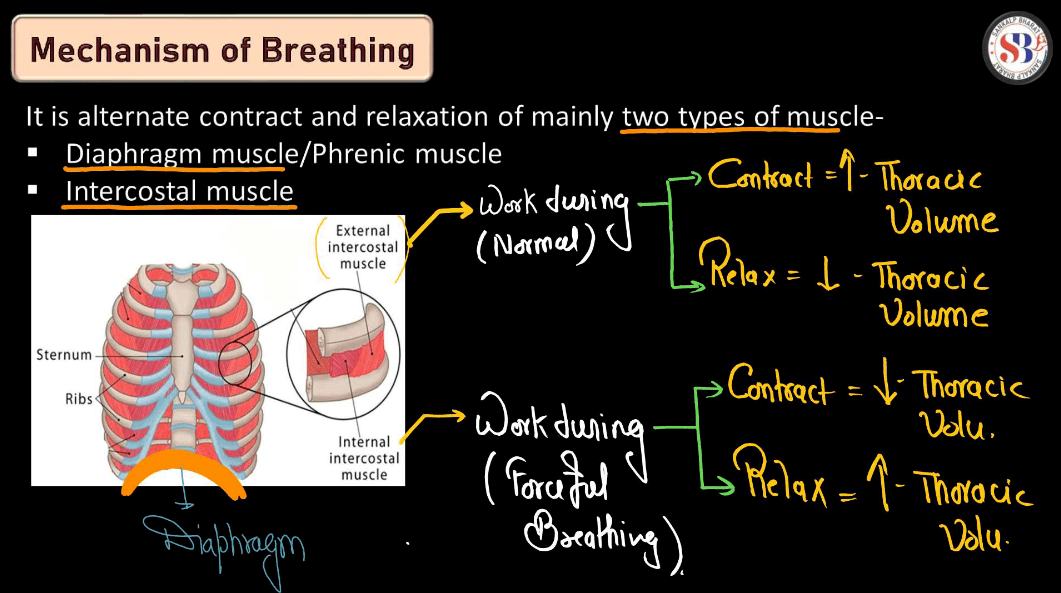
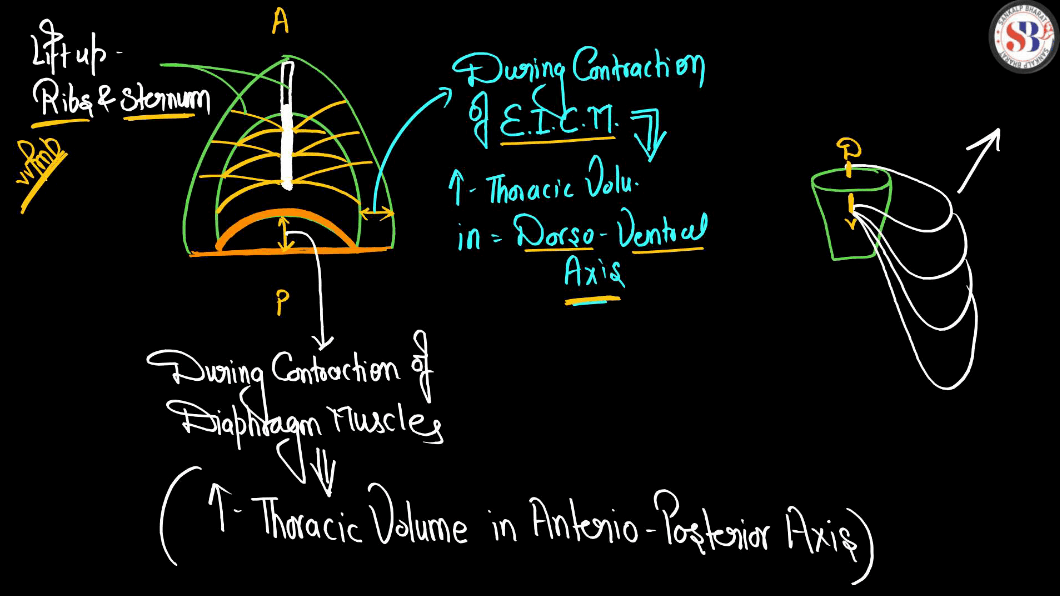
Inspiration
Inspiration or Inhalation is the process of breathing in air. When you take a breath, you draw air into your lungs through your nose or mouth. The air contains oxygen, which your body needs for various functions. As you inhale, your diaphragm, a muscle beneath your lungs, contracts, and your chest expands, creating a vacuum that pulls air into your respiratory system. Oxygen from the inhaled air is then absorbed into your bloodstream, providing the essential element your body uses to produce energy. Inspiration is a vital part of the respiratory process, ensuring your body receives the oxygen necessary for survival and proper functioning.
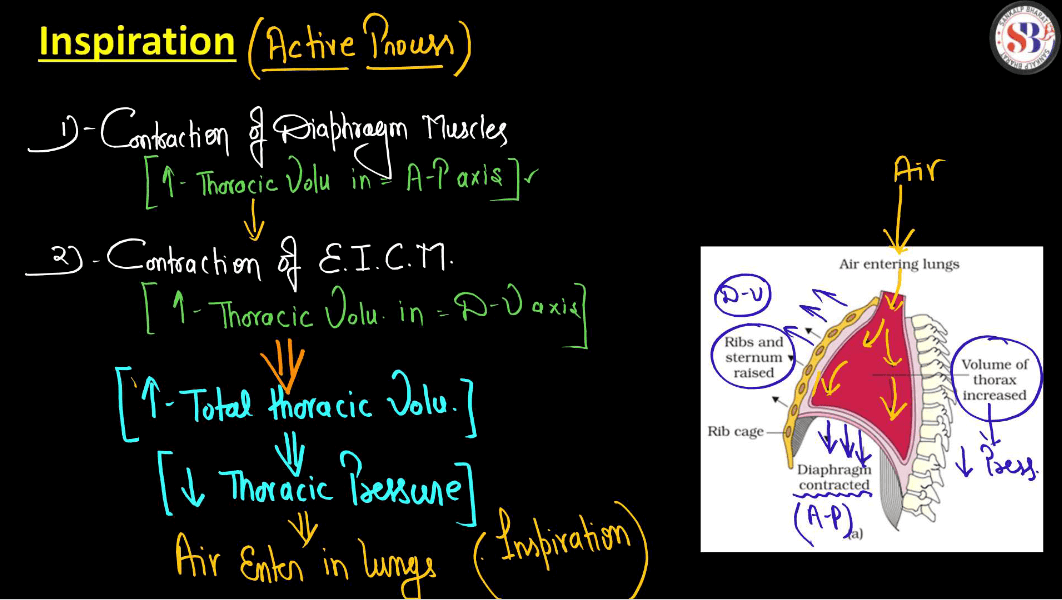
Process of Inspiration
Inspiration is the process of breathing in the air. The step-by-step process of inspiration has been discussed below. This cyclic process of inhalation and exhalation is vital for supplying oxygen to the body’s cells and removing carbon dioxide, supporting cellular functions and overall metabolism.
Step 1: Inspiration (Inhalation):
- Diaphragm Concentration: The diaphragm, a dome-shaped muscle below the lungs, contracts and moves downward.
- Intercostal Muscle Contraction: The external intercostal muscles between the ribs also contract, lifting the ribcage.
Step 2: Increased Thoracic Volume:
The combined action of the diaphragm and intercostal muscles expands the thoracic cavity, creating a lower pressure inside the lungs.
Step 3: Air Rushes In:
Due to the pressure difference, air rushes into the lungs from the higher atmospheric pressure outside.
Step 4: Lung Expansion:
The expansion of the lungs allows the alveoli (tiny air sacs) to fill with air, facilitating the exchange of oxygen and carbon dioxide.
Step 5: Oxygen Exchange:
Oxygen from the inhaled air passes through the thin walls of the alveoli into the bloodstream, while carbon dioxide from the bloodstream moves into the alveoli to be exhaled.
Step 6: Relaxation:
When the diaphragm and intercostal muscles relax, the thoracic cavity decreases in volume, and excess air is expelled during exhalation.
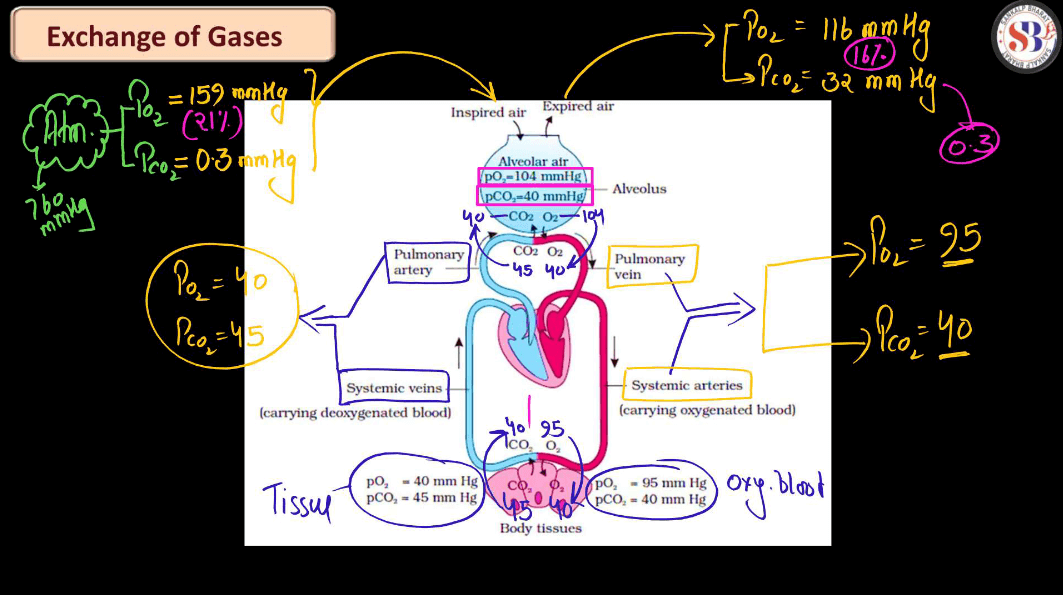
Expiration
Expiration or Exhalation is the process of breathing out, where the lungs release carbon dioxide, a waste product produced by our cells. During exhalation, the diaphragm, a muscle beneath the lungs, relaxes, and the chest cavity decreases in size. This compression forces the air, now rich in carbon dioxide, to be expelled from the lungs through the nose or mouth. Expiration is a crucial part of the respiratory cycle, ensuring the removal of excess carbon dioxide from the body. This continuous exchange of gases, with Inspiration bringing in oxygen and expiration removing carbon dioxide, supports the body’s energy production and helps maintain a balanced internal environment.
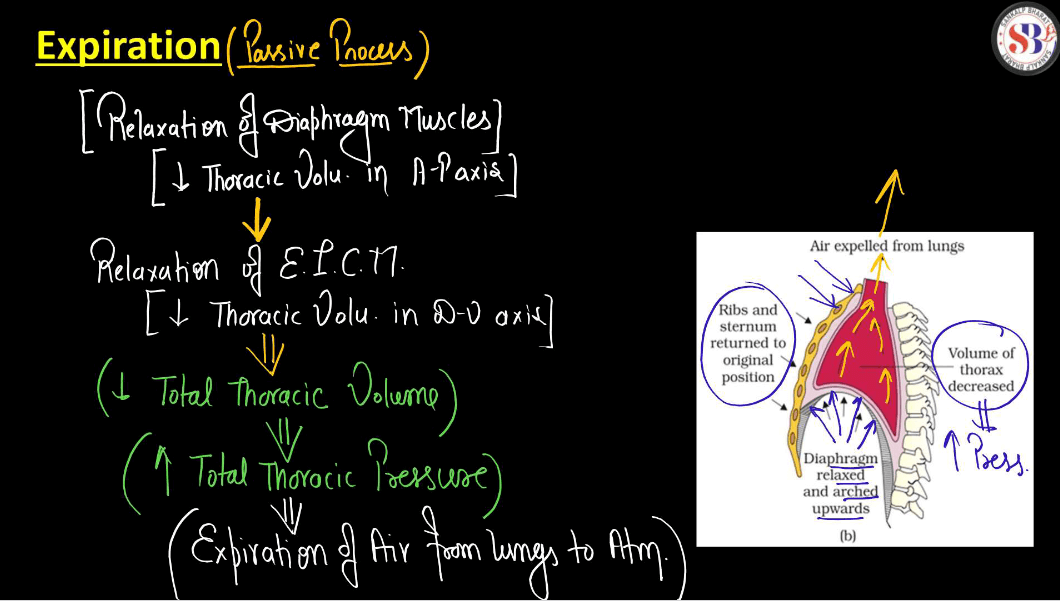
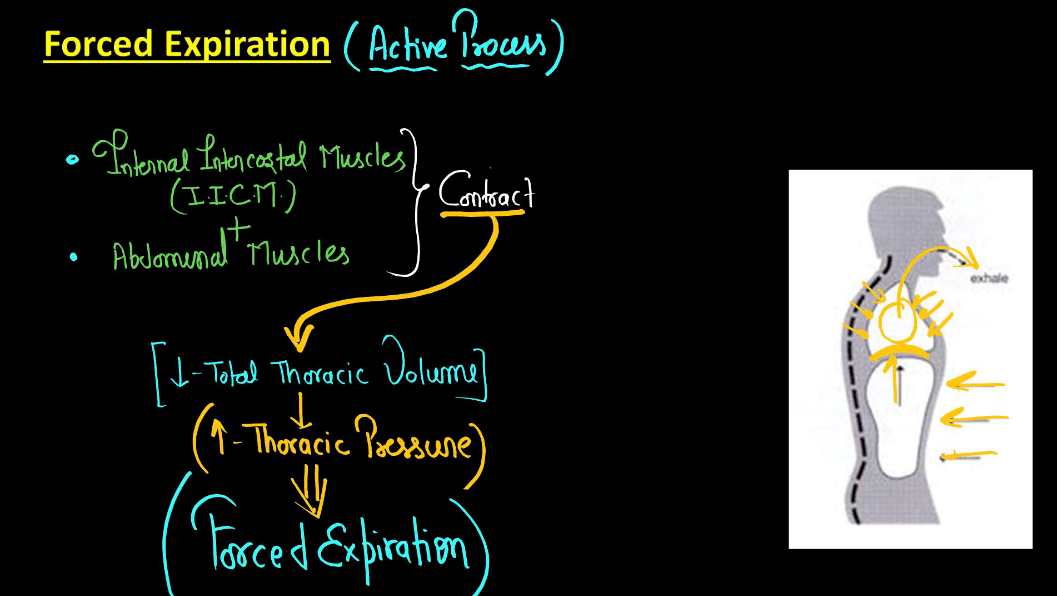
Process of Expiration
Expiration is the process of expelling air from the lungs. Here is a step-by-step breakdown of the complete expiration process. This process is passive during rest but can become more active during activities that require increased breathing, like exercise.
Step 1: Muscle Relaxation: The diaphragm, a dome-shaped muscle muscle below the lungs, and the intercostal muscles between the ribs relax.
Step 2: Volume Decrease: As the diaphragm and intercostal muscles relax, the volume in the chest cavity decreases.
Step 3: Pressure Increase: With the decrease in volume, the pressure within the lungs increases compared to the outside air.
Step 4: Airflow Out: The increased pressure forces air to flow out of the lungs, through the trachea, and out of the nose or mouth.
Step 5: Elastic Recoil: Elastic tissues in the lungs and chest wall recoil, aiding in pushing the air out.
Involved in the Mechanism of Breathing
Understanding these key points provides insight into the intricate mechanism of breathing.
- Inhalation (Inspiration): Diaphragm contracts and flattens, intercostal muscles lift ribs, increasing thoracic volume.
- Negative Pressure Gradient: Increased thoracic volume decreases pressure, causing air to rush into the lungs to equalize pressure.
- Exhalation (Expiration): Diaphragm and intercostal muscles relax, reducing thoracic volume.
- Positive Pressure Gradient: Decreased thoracic volume increases pressure, leading to air being pushed out of the lungs.
- Role of Lungs: Alveoli, small air sacs in the lungs, facilitate gas exchange (oxygen in, carbon dioxide out) with blood through diffusion.
- Control by Nervous System: Medulla oblongata and pons in the brain regulate breathing rate and depth based on factors like CO2 levels, ensuring homeostasis.
- Surfactant: Substance produced by alveoli to reduce surface tension, preventing lung collapse and aiding in efficient gas exchange.

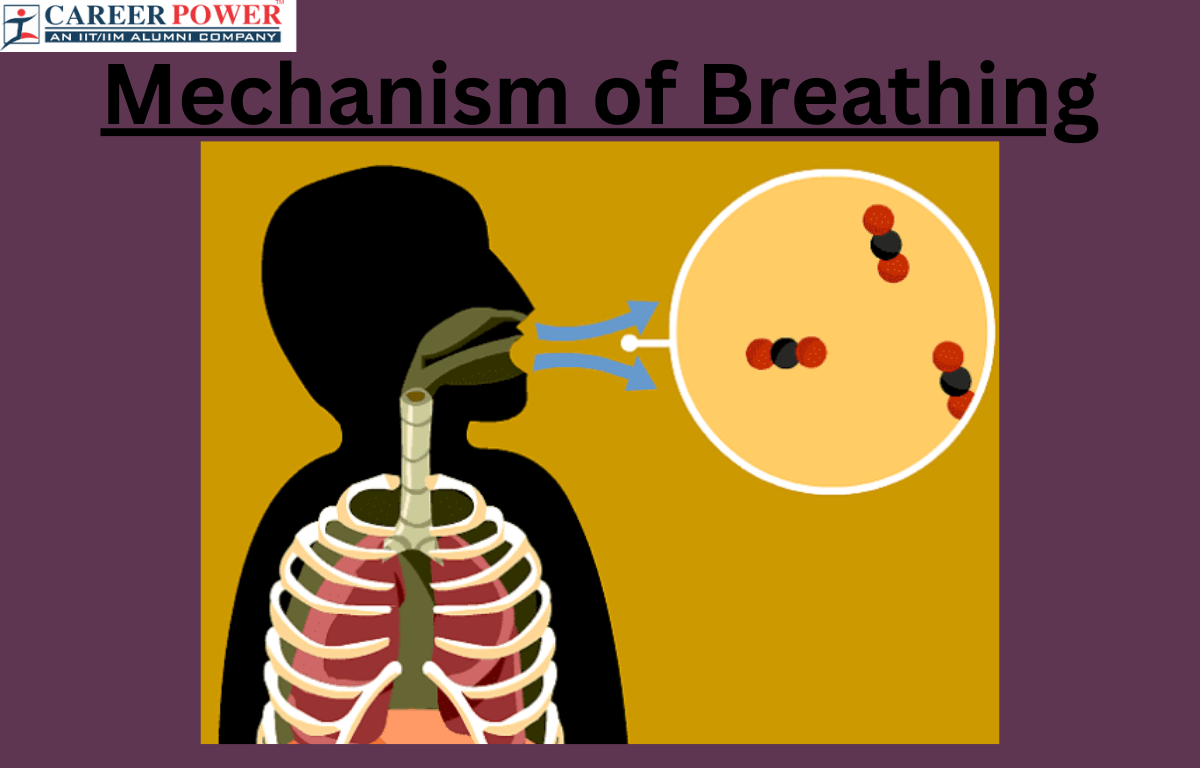

 50 Vegetables Name for Kids in English a...
50 Vegetables Name for Kids in English a...
 Food Chain: Definition, Types, Examples,...
Food Chain: Definition, Types, Examples,...
 Human Respiratory System: Definition, Di...
Human Respiratory System: Definition, Di...













